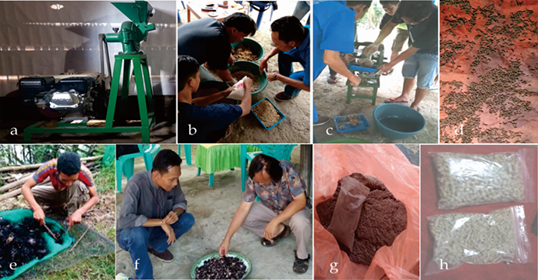Pembelajaran Pembuatan Pakan Mandiri dan Penstimulan Moulting Udang bagi Pembudidaya Tradisional The Learning to Make Independent Feed and Shrimp Moulting Stimulant for Traditional Farmers
Main Article Content
Abstract
Shrimp farming in Indonesia is dominated by traditional cultivation methods, therefore they do not have sufficient financial access to obtain expensive commercial feed. The Program for Application of Appropriate Technology (PTTG) aims to provide lessons on making independent feed and stimulating shrimp moulting for traditional farmers in Ma'rang District, Pangkajene and Islands Districts using local raw materials. The Participatory Rural Appraisal (PRA) approach model, which emphasizes the active involvement of the community in all activities, is used in this program. The knowledge and skills transferred from this study include the concept of artificial feed and moulting, preparation of raw materials, preparation of feed composition, mixing and weighing of raw materials, and pelleting and supplementation of feed. The results of the pre-test showed that the level of knowledge and skills regarding self-sufficient feed production and the manufacture of moulting-stimulating ingredients were generally in the poor category. However, after the learning activities, the post-test results showed that the level of knowledge and skills increased significantly and was generally in the good category. In general, partners believe that learning items are technically easy to apply, economically inexpensive, and ecologically can reduce agricultural and fishery waste. The lessons learned by traditional cultivators through this program can be utilized optimally in increasing production.
Downloads
Article Details

This work is licensed under a Creative Commons Attribution-ShareAlike 4.0 International License.
Authors who publish with this journal agree to the following terms:
- Any article on the copyright is retained by the author(s).
- Author grant the journal, right of first publication with the work simultaneously licensed under a Creative Commons Attribution License that allows others to share work with acknowledgment of the work authors and initial publications in this journal.
- Authors are able to enter into a separate, additional contractual arrangements for non-exclusive distribution of published articles of work (eg, post-institutional repository) or publish it in a book, with acknowledgment of its initial publication in this journal.
- Authors are permitted and encouraged to post their work online (e.g., in institutional repositories or on their websites) prior to and during the submission process, as can lead to productive exchanges, as well as earlier and greater citation of published work.
- The article and any associated published material is distributed under the Creative Commons Attribution-ShareAlike 4.0 International License
References
Akiyama, D. ., & Chwang, N. I. . (2005). Shrimp Feed Reguirements and Feed Management. Procedings of the South East Asian Shrimp Farm Management.
Arikunto, S. (2016). Prosedur Penelitian Suatu Pendekatan Praktik. Rineka Cipta, Jakarta.
Hakim, R. R. (2012). Calcium addition on foods to increase frequency of Cherax quadricarinatus moulting. Jurnal Gamma, V(September). http://202.52.52.22/index.php/gamma/article/viewFile/757/2859
Handoko, E. Y., . Y., & Ariani, R. (2020). Analisis Kenaikan Muka Air Laut Indonesia Tahun 1993-2018 Menggunakan Data Altimetri. Geoid, 15(1), 58. https://doi.org/10.12962/j24423998.v15i1.3958
Heriansah, Nursyahran, Fathuddin, Alifia, F., Rifal, M., Anzar, A., & Reza, M. F. (2022). Signifikansi daya cerna dan rasio konversi pakan yang dilapisi tepung kopepoda (Oithona sp.) pada udang vaname (Litopenaeus vannamei) : Suatu aplikasi praktis. Prosiding Semnas Politani Pangkep, 3(September). https://doi.org/https://doi.org/10.51978/proppnp.v3i1.269
Heriansah, Nursyahran, Nursidi, Nursida, N. F., & Najamuddin. (2021). Practical application of sea urchin shell flour supplementation as a stimulant moulting in vannamei shrimp. DEPIK Jurnal Ilmu-Ilmu Perairan, Pesisir dan Perikanan, 10(2), 107–114. https://doi.org/https://doi.org/10.13170/ depik.10.2.19456
Jumiati, Maulana, N., Heriansah, Lapong, I., & Kabangnga, A. (2023). Potensi ko-kultur (Caulerpa lentillifera) dan udang windu (Penaeus monodon) di tambak tradisional air payau. Jurnal Juvenil, 4(1), 21–30. https://doi.org/http://doi.org/10.21107/juvenil.v4i1.18563
Kumar, G., Engle, C., & Tucker, C. (2018). Factors Driving Aquaculture Technology Adoption. Journal of the World Aquaculture Society, 49(3), 447–476. https://doi.org/10.1111/jwas.12514
Lemos, D., & Weissman, D. (2021). Moulting in the grow-out of farmed shrimp: a review. Reviews in Aquaculture, 13(1), 5–17. https://doi.org/10.1111/raq.12461
Nasution, Z., & Yanti, B. V. I. (2015). Adopsi Teknologi Budidaya Udang Secara Intensif Di Kolam Tambak. Jurnal Kebijakan Sosial Ekonomi Kelautan Dan Perikanan, 5(1), 1. https://doi.org/10.15578/jksekp.v5i1.1070
Nunes, A. J. P., Sabry-Neto, H., Oliveira-Neto, S., & Burri, L. (2019). Feed preference and growth response of juvenile Litopenaeus vannamei to supplementation of marine chemoattractants in a fishmeal-challenged diet. Journal of the World Aquaculture Society, 50(6), 1048–1063. https://doi.org/10.1111/jwas.12648
Nursidi, N., Heriansah, H., Fathuddin, F., & Nursida, N. F. (2021). Pemanfaatan Ruang Akuakultur Potensial melalui Diseminasi Teknologi Budidaya Metode Vertikal untuk Meningkatkan Kapasitas Pembudidaya dan Produksi Rumput Laut di Pesisir Desa Ujung Baji Kabupaten Takalar. Engagement: Jurnal Pengabdian Kepada Masyarakat, 5(1), 207 - 220. https://doi.org/10.52166/engagement.v5i1.644.
Sari, K., Alamsyah, P., Yuka Asmara, A., Kusnandar, K., & Mulatsih, S. (2017). Critical Role of Intermediaries on Technology Transfer: Case Study of BIOTROP and Center for Mariculture Development of Lampung. Jurnal Manajemen Teknologi, 16(1), 33–45. https://doi.org/10.12695/jmt.2017.16.1.3
Sitorus, Y. L. M. (2017). Community Driven Development in Traditional Communities in Papua. Journal of Regional and City Planning, 28(1), 16–31. https://doi.org/10.5614/jrcp.2017.28.1.2
Zulhisyam, A. K., Kabir, M. A., Munir, M. B., & Wei, L. S. (2020). Using of Fermented Soy Pulp as an Edible Coating Material on Fish Feed Pellet in African Catfish (Clarias gariepinus) Production. AACL Bioflux, 13(1), 296–308.
